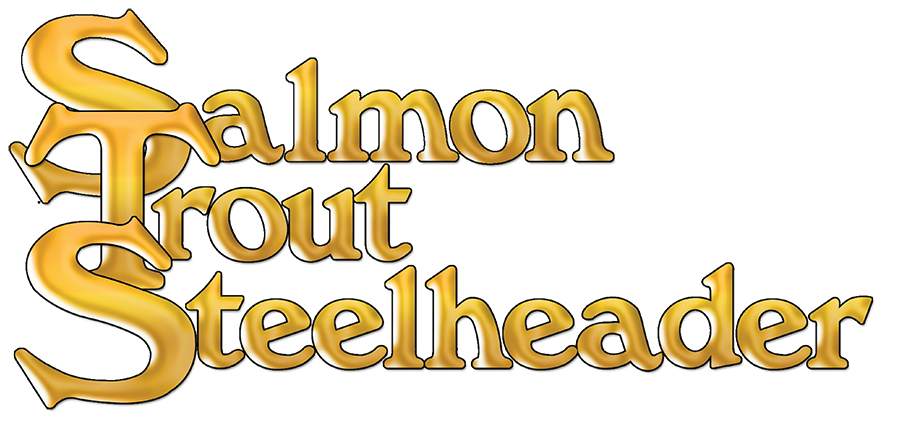In salmon streams in the spring and early summer up and down the Pacific Northwest, B.C. and Alaska, you get one of nature’s great collisions—when millions of out-migrating salmon fry and smolt smash head-on into hordes of hungry Dollies, rainbows and cutthroat.

This nice cannibal rainbow was hooked swinging a smolt pattern and grabbed on the very first strip.
It’s life and death in the wild as Mother Nature herself intended it… but what she probably didn’t consider is the fact that this epic drama also creates quite an opportunity for anglers to get in on some light tackle fun.
When the little salmon are making a break for saltwater, char and trout get awfully stupid and you can have some absolutely banner days when fishing small minnow patterns on spinning or fly gear.
TIMING
The first thing to consider in your local area is the timing of the salmon’s downstream migration. Basically, the further north you go, the later the out-migration. In Northern California, little chinook start to head downstream in February and March and continue into May, but it can be as late as July in Alaska. It all has to do with a river’s character, ambient air and water temperatures and the variety of salmon smolt that it contains. As a basic rule of thumb, late spring and early summer is go time.
LOCATIONS
Well, obviously, you want to start with a river that has good runs of salmon. Streams with solid populations of several varieties of salmon are the best and I prefer somewhat longer systems— just so you have a more drawn-out fishing period. Of course the flip side to that is, short drainages may only fish well during the spring out-migration period for a brief time, but hit it right and you should find major concentrations of bows, Dollies and cutties.
As far as specific spots to target go, lake outlets are usually as deadly as it gets—especially on streams that have good populations of coho and sockeye salmon. Those varieties in particular like to spawn in tributaries above lakes, so spring trout fishing can be epic at the outlet as the clouds of baby salmon head for the sea. Moving downstream, the mouths of feeder creeks are also stacking zones for little salmon—and the trout that feed on them. The base of a major rapid, falls or dam is also worthy of investigation as the predators target the little guys as they struggle to get their bearings after washing out of the whitewater.
Cutthroat will congregate in the lower portions of rivers—usually in and around tidewater. They do their hunting more ambush-style, hanging out in slower water around woody cover. River mouths are, of course, also extremely productive—especially for char. While Dollies will eagerly dash upstream to intercept the fry’s down-stream migration, there are some that also seem to prefer to just hang in saltwater and wait for the food to come to them.

This chunky Dolly mistook an epoxy fly for a baby salmon.
Keep in mind that juvenile fish tend to migrate along the margins of the river, seeking cover from predators near grassy banks, fallen timber and boulders—and that’s where you should concentrate your efforts. In high water, the target zones actually get even easier to locate as the fish—hunters and the hunted—get piled up into soft edges.
One of the inherent beauties of targeting salmon-eating trout and char is that it’s pretty simple, easy fishing. There’s not a whole lot of mystery to what the fish are munching on, so therefore, matching the hatch is not a big problem. Regardless of what you’re using—hardware or flies—you’re going to want something with a green back and silvery sides.
If you’re fishing with fly gear, small Clousers, Krystal Buggers, leeches, muddlers and epoxy minnows work well. A basic hardware kit should include Size No. 2-4 Panther Martin spinners along with No. 0-3 Mepps and Blue Fox spinners. Small Kastmasters and Little Cleos are good selections as well, and ripping small rip baits like Lucky Craft Pointers is also a kick.
While picking a color pattern is a no-brainer here, there is something to be said for carefully paying attention to the silhouette of your bait. In other words, matching the size of your offering to the size of the baby fish is important. Predators like trout and char can get so dialed into a particular size of food that they ignore anything that’s out of that range. This is especially true when there are vast schools of juvenile fish in the river—with so much natural food around, it doesn’t make much for a fish to pay no attention to your lure if it looks a little different from real thing.
GEAR
No need to get fancy here—your basic lightweight spinning rod spooled up with 6-pound mono is all you’ll need for throw-ing hardware. A 4- to 6-weight fly rod with either a dry line (bring some splitshot) or a sink tip will cover most fluff-chucking situations, though on larger rivers you may want to throw a shooting head in for good measure.
When throwing lures, it’s a good idea to swap out the stock treble hooks with singles and then pinch the barbs—that way you can quickly and safely release fish. And when the bite is on, you’ll be doing that often.
GET OUT THERE!
Again, this is a pretty simple fishery—find the right area and match your lure or fly to the size of the “baitfish” and you’re going to get bit. I like it because it can be a nice filler activity between seasons in some areas—and it also reminds me of the good ol’ days of trout fishing as a kid. Only these trout are on steroids!
JD Richey is a full-time guide and member of the California Outdoor Hall of Fame. Check him out at: www.thesportfisher.com









1 comment
Another great article from J.D. Keep ’em coming!